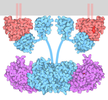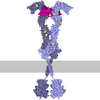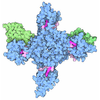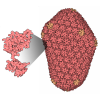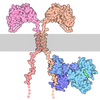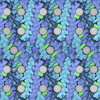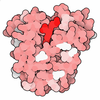+ Open data
Open data
- Basic information
Basic information
| Entry | Database: PDB / ID: 9j38 | |||||||||||||||||||||
|---|---|---|---|---|---|---|---|---|---|---|---|---|---|---|---|---|---|---|---|---|---|---|
| Title | human KCNQ5-CaM in apo state | |||||||||||||||||||||
 Components Components |
| |||||||||||||||||||||
 Keywords Keywords | MEMBRANE PROTEIN / voltage-gated potassium channel | |||||||||||||||||||||
| Function / homology |  Function and homology information Function and homology informationclathrin coat / Voltage gated Potassium channels / CaM pathway / Cam-PDE 1 activation / Sodium/Calcium exchangers / Calmodulin induced events / positive regulation of ryanodine-sensitive calcium-release channel activity / Reduction of cytosolic Ca++ levels / Activation of Ca-permeable Kainate Receptor / CREB1 phosphorylation through the activation of CaMKII/CaMKK/CaMKIV cascasde ...clathrin coat / Voltage gated Potassium channels / CaM pathway / Cam-PDE 1 activation / Sodium/Calcium exchangers / Calmodulin induced events / positive regulation of ryanodine-sensitive calcium-release channel activity / Reduction of cytosolic Ca++ levels / Activation of Ca-permeable Kainate Receptor / CREB1 phosphorylation through the activation of CaMKII/CaMKK/CaMKIV cascasde / Loss of phosphorylation of MECP2 at T308 / CREB1 phosphorylation through the activation of Adenylate Cyclase / CaMK IV-mediated phosphorylation of CREB / PKA activation / negative regulation of high voltage-gated calcium channel activity / Glycogen breakdown (glycogenolysis) / CLEC7A (Dectin-1) induces NFAT activation / Activation of RAC1 downstream of NMDARs / organelle localization by membrane tethering / negative regulation of ryanodine-sensitive calcium-release channel activity / mitochondrion-endoplasmic reticulum membrane tethering / autophagosome membrane docking / negative regulation of calcium ion export across plasma membrane / regulation of cardiac muscle cell action potential / presynaptic endocytosis / Synthesis of IP3 and IP4 in the cytosol / regulation of cell communication by electrical coupling involved in cardiac conduction / Phase 0 - rapid depolarisation / calcineurin-mediated signaling / Negative regulation of NMDA receptor-mediated neuronal transmission / Unblocking of NMDA receptors, glutamate binding and activation / RHO GTPases activate PAKs / Ion transport by P-type ATPases / Uptake and function of anthrax toxins / regulation of ryanodine-sensitive calcium-release channel activity / Long-term potentiation / protein phosphatase activator activity / Calcineurin activates NFAT / Regulation of MECP2 expression and activity / voltage-gated potassium channel activity / DARPP-32 events / catalytic complex / Smooth Muscle Contraction / detection of calcium ion / regulation of cardiac muscle contraction / RHO GTPases activate IQGAPs / regulation of cardiac muscle contraction by regulation of the release of sequestered calcium ion / calcium channel inhibitor activity / cellular response to interferon-beta / presynaptic cytosol / Protein methylation / Activation of AMPK downstream of NMDARs / Ion homeostasis / regulation of release of sequestered calcium ion into cytosol by sarcoplasmic reticulum / eNOS activation / titin binding / Tetrahydrobiopterin (BH4) synthesis, recycling, salvage and regulation / sperm midpiece / voltage-gated potassium channel complex / regulation of calcium-mediated signaling / potassium ion transmembrane transport / calcium channel complex / substantia nigra development / FCERI mediated Ca+2 mobilization / Ras activation upon Ca2+ influx through NMDA receptor / regulation of heart rate / FCGR3A-mediated IL10 synthesis / adenylate cyclase activator activity / calyx of Held / Antigen activates B Cell Receptor (BCR) leading to generation of second messengers / protein serine/threonine kinase activator activity / VEGFR2 mediated cell proliferation / sarcomere / regulation of cytokinesis / VEGFR2 mediated vascular permeability / Translocation of SLC2A4 (GLUT4) to the plasma membrane / spindle microtubule / positive regulation of receptor signaling pathway via JAK-STAT / RAF activation / Transcriptional activation of mitochondrial biogenesis / Stimuli-sensing channels / cellular response to type II interferon / long-term synaptic potentiation / response to calcium ion / RAS processing / spindle pole / Signaling by RAF1 mutants / Signaling by moderate kinase activity BRAF mutants / Paradoxical activation of RAF signaling by kinase inactive BRAF / Signaling downstream of RAS mutants / calcium-dependent protein binding / G2/M transition of mitotic cell cycle / Signaling by BRAF and RAF1 fusions / Inactivation, recovery and regulation of the phototransduction cascade / Platelet degranulation / myelin sheath / Ca2+ pathway / RAF/MAP kinase cascade / High laminar flow shear stress activates signaling by PIEZO1 and PECAM1:CDH5:KDR in endothelial cells / vesicle Similarity search - Function | |||||||||||||||||||||
| Biological species |  Homo sapiens (human) Homo sapiens (human) | |||||||||||||||||||||
| Method | ELECTRON MICROSCOPY / single particle reconstruction / cryo EM / Resolution: 2.4 Å | |||||||||||||||||||||
 Authors Authors | Yang, Z. / Guo, J. | |||||||||||||||||||||
| Funding support |  China, 1items China, 1items
| |||||||||||||||||||||
 Citation Citation |  Journal: Proc Natl Acad Sci U S A / Year: 2025 Journal: Proc Natl Acad Sci U S A / Year: 2025Title: Phosphatidylinositol 4,5-bisphosphate activation mechanism of human KCNQ5. Authors: Zhenni Yang / Yueming Zheng / Demin Ma / Long Wang / Jiatong Zhang / Tiefeng Song / Yong Wang / Yan Zhang / Fajun Nan / Nannan Su / Zhaobing Gao / Jiangtao Guo /  Abstract: The human voltage-gated potassium channels KCNQ2, KCNQ3, and KCNQ5 can form homo- and heterotetrameric channels that are responsible for generating the neuronal M current and maintaining the membrane ...The human voltage-gated potassium channels KCNQ2, KCNQ3, and KCNQ5 can form homo- and heterotetrameric channels that are responsible for generating the neuronal M current and maintaining the membrane potential stable. Activation of KCNQ channels requires both the depolarization of membrane potential and phosphatidylinositol 4,5-bisphosphate (PIP). Here, we report cryoelectron microscopy structures of the human KCNQ5-calmodulin (CaM) complex in the apo, PIP-bound, and both PIP- and the activator HN37-bound states in either a closed or an open conformation. In the closed conformation, a PIP molecule binds in the middle of the groove between two adjacent voltage-sensing domains (VSDs), whereas in the open conformation, one additional PIP binds to the interface of VSD and the pore domain, accompanying structural rearrangement of the cytosolic domain of KCNQ and CaM. The structures, along with electrophysiology analyses, reveal the two different binding modes of PIP and elucidate the PIP activation mechanism of KCNQ5. | |||||||||||||||||||||
| History |
|
- Structure visualization
Structure visualization
| Structure viewer | Molecule:  Molmil Molmil Jmol/JSmol Jmol/JSmol |
|---|
- Downloads & links
Downloads & links
- Download
Download
| PDBx/mmCIF format |  9j38.cif.gz 9j38.cif.gz | 394.3 KB | Display |  PDBx/mmCIF format PDBx/mmCIF format |
|---|---|---|---|---|
| PDB format |  pdb9j38.ent.gz pdb9j38.ent.gz | 316 KB | Display |  PDB format PDB format |
| PDBx/mmJSON format |  9j38.json.gz 9j38.json.gz | Tree view |  PDBx/mmJSON format PDBx/mmJSON format | |
| Others |  Other downloads Other downloads |
-Validation report
| Summary document |  9j38_validation.pdf.gz 9j38_validation.pdf.gz | 1.2 MB | Display |  wwPDB validaton report wwPDB validaton report |
|---|---|---|---|---|
| Full document |  9j38_full_validation.pdf.gz 9j38_full_validation.pdf.gz | 1.2 MB | Display | |
| Data in XML |  9j38_validation.xml.gz 9j38_validation.xml.gz | 57.3 KB | Display | |
| Data in CIF |  9j38_validation.cif.gz 9j38_validation.cif.gz | 81.7 KB | Display | |
| Arichive directory |  https://data.pdbj.org/pub/pdb/validation_reports/j3/9j38 https://data.pdbj.org/pub/pdb/validation_reports/j3/9j38 ftp://data.pdbj.org/pub/pdb/validation_reports/j3/9j38 ftp://data.pdbj.org/pub/pdb/validation_reports/j3/9j38 | HTTPS FTP |
-Related structure data
| Related structure data |  61109MC  9lizC 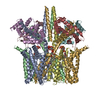 9lj1C 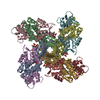 9lj5C M: map data used to model this data C: citing same article ( |
|---|---|
| Similar structure data | Similarity search - Function & homology  F&H Search F&H Search |
- Links
Links
- Assembly
Assembly
| Deposited unit | 
|
|---|---|
| 1 |
|
- Components
Components
| #1: Protein | Mass: 68776.484 Da / Num. of mol.: 4 Source method: isolated from a genetically manipulated source Source: (gene. exp.)  Homo sapiens (human) / Gene: KCNQ5 / Cell line (production host): HEK293 / Production host: Homo sapiens (human) / Gene: KCNQ5 / Cell line (production host): HEK293 / Production host:  Homo sapiens (human) / References: UniProt: Q9NR82 Homo sapiens (human) / References: UniProt: Q9NR82#2: Protein | Mass: 16852.545 Da / Num. of mol.: 4 Source method: isolated from a genetically manipulated source Source: (gene. exp.)  Homo sapiens (human) / Gene: CALM1, CALM, CAM, CAM1 / Cell line (production host): HEK293 / Production host: Homo sapiens (human) / Gene: CALM1, CALM, CAM, CAM1 / Cell line (production host): HEK293 / Production host:  Homo sapiens (human) / References: UniProt: P0DP23 Homo sapiens (human) / References: UniProt: P0DP23Has protein modification | N | |
|---|
-Experimental details
-Experiment
| Experiment | Method: ELECTRON MICROSCOPY |
|---|---|
| EM experiment | Aggregation state: PARTICLE / 3D reconstruction method: single particle reconstruction |
- Sample preparation
Sample preparation
| Component | Name: human KCNQ5-CaM in apo state / Type: COMPLEX / Entity ID: all / Source: RECOMBINANT |
|---|---|
| Source (natural) | Organism:  Homo sapiens (human) Homo sapiens (human) |
| Source (recombinant) | Organism:  Homo sapiens (human) / Cell: Hek293 Homo sapiens (human) / Cell: Hek293 |
| Buffer solution | pH: 8 |
| Specimen | Embedding applied: NO / Shadowing applied: NO / Staining applied: NO / Vitrification applied: YES |
| Vitrification | Cryogen name: ETHANE |
- Electron microscopy imaging
Electron microscopy imaging
| Experimental equipment |  Model: Titan Krios / Image courtesy: FEI Company |
|---|---|
| Microscopy | Model: FEI TITAN KRIOS |
| Electron gun | Electron source:  FIELD EMISSION GUN / Accelerating voltage: 300 kV / Illumination mode: FLOOD BEAM FIELD EMISSION GUN / Accelerating voltage: 300 kV / Illumination mode: FLOOD BEAM |
| Electron lens | Mode: BRIGHT FIELD / Nominal defocus max: 1600 nm / Nominal defocus min: 800 nm / Cs: 2.7 mm |
| Image recording | Electron dose: 52 e/Å2 / Film or detector model: GATAN K2 QUANTUM (4k x 4k) |
- Processing
Processing
| CTF correction | Type: PHASE FLIPPING AND AMPLITUDE CORRECTION |
|---|---|
| 3D reconstruction | Resolution: 2.4 Å / Resolution method: FSC 0.143 CUT-OFF / Num. of particles: 314095 / Symmetry type: POINT |
 Movie
Movie Controller
Controller






 PDBj
PDBj







